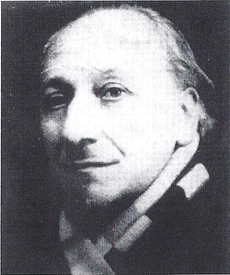Henri Mulet
Henri Mulet (12 October 1878 - 20 September 1967) was a French composer, organ, harmonium and cello player.

Biography
Mulet was born on 17 October 1878 in Paris. His father Gabriel was choirmaster of the Basilica of Sacré-Cœur, where his mother would also play the harmonium; as a boy he sometimes deputised for her. He studied at the Paris Conservatoire from 1890, where his teachers included Jules Delsart, Raoul Pugno, Xavier Leroux, Alexandre Guilmant and Charles-Marie Widor. He originally intended to be a cellist, but later served as an organist at Saint-Pierre-de-Montrouge and also taught at the École Niedermeyer and the Schola Cantorum, where he worked with his friend Vincent d'Indy. From 1922 to 1937 he was organist at St. Phillippe du Roule.[1][2]
Mulet's most notable works are for organ: the Esquisses byzantines (1914-1919) and the Carillon sortie (1911/12). The former, a set of ten pieces, was a recollection of the Romano-Byzantine style of Sacré-Cœur and five of the pieces are named after some of its architectural features, including "Campanile" (bell-tower) and "Chapelle des Morts" (chapel of the dead). The Carillon has been called "one of the great showpieces of French Romantic organ music".[2] Mulet's complete organ works were published in a set of two CDs in 1989, played by Paul Derett.[3]
In 1922 Mulet published "Les tendances et antireligieuses néfastes de l'orgue moderne", an attack on modern schools of organ building;this was followed by similar essays. He deplored the trend to create organs which he felt were more appopriate for the cinema than for church: the organ was "a stained-glass window. Its tones of imposing and embracing calm flood the air of our cathedrals, in the same way that ...stained-glass windows bring doen meditation upon the congregation."[2]
In 1937, Mulet, following a financial crisis, destroyed his manuscripts and many of his possessions and left Paris for Draguignan. There he continued as organist until 1958, often in poverty (his wife opened a toyshop in the hope of increasing their income). Ill-health led Mulet and his wife to retire to a convent in Draguignan, where he died in 1967.[1] [2][4]
Works
Organ
- Méditation religieuse, 1896?
- Prière, 1902?
- Carillon-Sortie, Procure Générale, 1911 or 1912?
- Offertoire funèbre
- Petit offertoire - Maurice Senart, 1912 reprinted by Edition: "Le Grand Orgue"
- Sortie douce - Maurice Senart, 1912 reprinted by Edition: "Le Grand Orgue"
- Offertoire sur un Alléluia grégorien, pour la fête du Très-Saint-Rosaire
- Esquisses Byzantines (10 pieces), 1914–19.
Harmonium
- Angelus (a transcription of his earlier orchestral work "San Salvator").
- Offertoire
- Sortie
Orchestral
- Dans la vallée du tombeau (Souvenir de Lombardie), symphonic poem, 1908
- La Toussaint, symphonic poem, 1909
- Fantaisie pastorale, 1911
- Paysage d’hiver
- Paysages crépusculaires
- Scherzo-Marche
- Petite suite sur des airs populaires français
- Souvenirs de Lombardie
Vocal
- O mon Jésus (hymn), 1900
- L’aigu bruissement, voice and piano, 1904
- Laudate dominum, four voices and organ, 1904
- Soleils couchants, voice and piano, 1904
- Ave Maria, three voices & organ, 1910
- Les deux étoiles, voice and piano, 1910
- Le dernier des Maourys, voice and piano, 1911
- Le talion, voice and orchestra, 1912 (on a text by LeConte de Lisle).
Chamber and instrumental
- Danse afghane, piano, 1904
- 2 noëls, oboe or clarinet & piano, 1904
- Danse persane, piano, 1910
- Petit lied très facile, harpsichord or piano, 1910
Essays
- Les tendances et antireligieuses néfastes de l'orgue modern. Congres General de Musique Sacree, Strassbourg 26-31 Juillet 1921.
- Étude sur le role des mutations et la composition rationelle du Plein-Jeu dans un grand orgue, Strassbourg 26-31 Juillet 1921.
References
- Notes
- Bate (1980), pp. 766-767
- Plender (1981), pp. 967, 969-767
- Nickol (1989), p. 439.
- Simeone (2000), p. 165.
- Sources
- Bate, Jennifer (1980). "Mulet, Henri", in The New Grove Dictionary of Music and Musicians, ed. S. Sadie, vol.12, pp. 766–7. ISBN 0333231112
- Nickol, Christopher (1989). "Complete Mulet". The Musical Times, Vol. 130, No. 1757, p. 439. (subscription required)
- Plender, Aidan (October 1981). "Henri Mulet, 1878-1967". The Musical Times, Vol. 122, No. 1664, p. 697 and 699. (subscription required)
- Simeone, Nigel (2000). Paris--a Musical Gazetteer, p. 165. Yale University Press. ISBN 0300080549
- Further reading
- Duchesneau, Michel (1997). L'avant-garde musicale et ses sociétés à Paris de 1871 à 1939. Sprimont: Editions Mardaga
- Sabatier, F (1991) ‘Henri Mulet’, Guide de la musique d’orgue, ed. G. Cantagrel (Paris), 605–6
- Smith, Rollin (1999). Louis Vierne: Organist of Notre-Dame Cathedral, p. 199, note 171. Pendragon Press. ISBN 1576470040
External links
- Ioannis Dimitroulis, "Henri Mulet", in Classicalcomposers.org website. Retrieved via Wayback Machine 18 October 2017.
- Henri Mulet: A biography by Ioannis Dimitroulis,